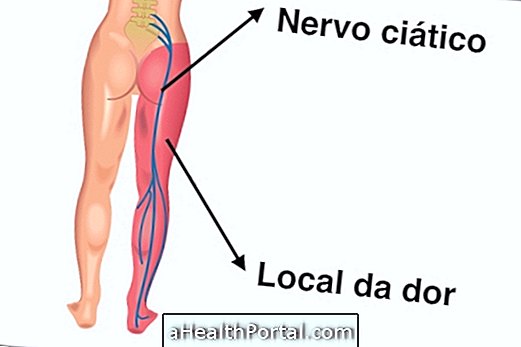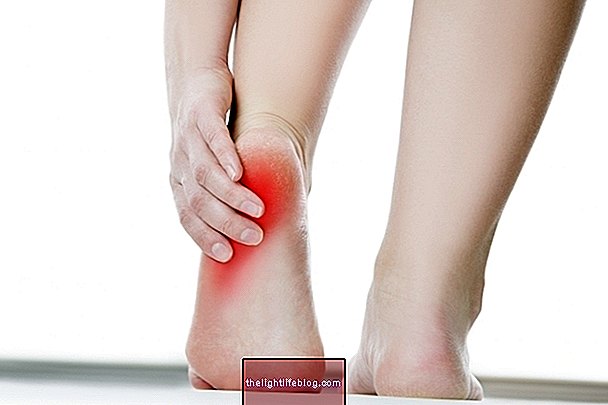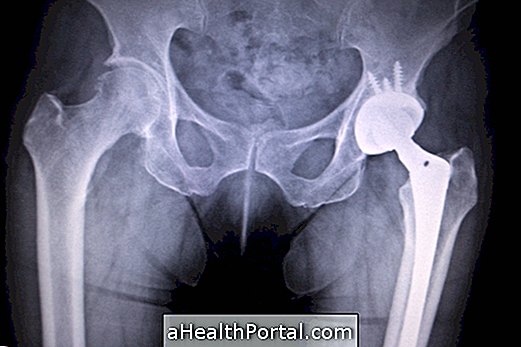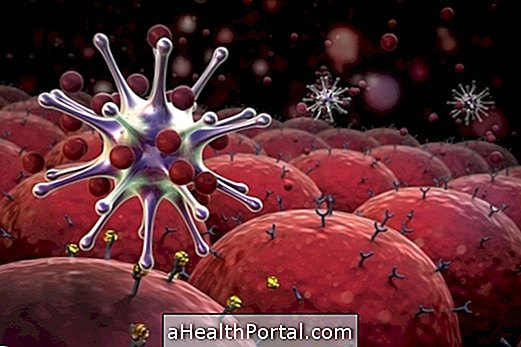In order to cure the inflamed sciatic nerve, the treatment indicated by the orthopaedist or the physiotherapist, with remedies, exercises, and sometimes physiotherapy, should be performed.
The sciatic nerve is the largest nerve in the human body, being formed by several nerve roots that comes from the spine. The sciatic nerve begins at the end of the spine, passing through the buttocks and back of the thigh, and when it reaches the knee it divides between the common tibial and fibular nerve and reaches the feet. And it is on this whole journey that he can cause pain with tingling sensation, stinging or electric shock.
When there is compression or inflammation of this nerve, sciatica arises that causes symptoms such as intense pain in the back, gluteus or legs, difficulty in keeping the spine erect and pain when walking. In these cases it is important to seek an orthopedic doctor or physiotherapist so that he can guide the proper treatment.

Symptoms of Inflamed Sciatic Nerve
If you think you may have an inflammation of the sciatic nerve, select your symptoms and know what your chances are:
- 1. Pain in tingling, numbness or shock in the spine, gluteal, leg or sole of the foot. Yes No
- 2. Burning sensation, cracked or tired leg. Yes No
- 3. Weakness in one or both legs. Yes No
- 4. Pain that gets worse by staying too long. Yes No
- 5. Difficulty walking or staying too long in the same position. Yes No

Often these symptoms are associated with changes in the spine, such as herniated disc, spondylolisthesis or even arthrosis in the spine. For this reason, when the first symptoms appear it is very important to consult an orthopedist or a physiotherapist so that tests are performed in the office and X-ray examinations of the spine are performed to assess if the spine has any changes that are compressing the nerve giving symptoms.
When the person exhibits other symptoms such as pinching sensation, burning, and feeling of tired and heavy legs, this has no relation to the sciatic nerve, but are characteristic of the myofascial pain syndrome, which is often confused with sciatic nerve alterations. Learn how to identify and treat this syndrome.
How To Know if It Is Sciatica
The diagnosis of sciatica can be made by the orthopedist or physiotherapist based on the signs and symptoms presented. The test that consists of checking the sciatic nerve alteration can be done in the office: lying on the stomach and lifting the stretched leg of the stretcher, if there is pain or tingling, the test indicates sciatic compression. If there is pain in the other leg, this indicates a severe alteration of the spine, such as an herniated disc, for example.
Imaging tests such as X-rays and MRIs may be helpful in evaluating the spine, helping to identify what is compressing the nerve. If the spine is healthy and unchanged, the cause of sciatica should be only muscle or fascia, and the treatment is relatively simpler.
When it is suspected that the nerve is even damaged, which rarely happens, only in the event of a serious accident, it may be necessary to perform an electroneuromyogram, which is an examination that evaluates the functioning of the nerve itself.
Treatments for sciatic nerve

Treatment for sore or inflamed sciatic nerve can be done with the use of analgesic remedies, anti-inflammatory pills, ointments, use of heat pockets and physiotherapy with specific exercises. The options are:
1. Remedies
The remedies indicated to combat sciatic pain may be Paracetamol, Ibuprofen, or the stronger, derived from morphine such as Tramadol, but a muscle relaxant and Diazepan may also be indicated by the orthopedist. But a more natural way of fighting pain is to take the vitamin B complex, as this improves the health of the body's nerves.
2. Massage
Massage with moisturizing cream or essential oils is one of the best home treatment options for inflamed sciatic nerve because it serves to relieve pain and improve movement because it relaxes the muscles of the back, legs and buttocks, thereby decreasing nerve compression, but preferably should be performed by a masseur or physiotherapist and does not exclude the need for treatment in the clinic.
3. Exercises
Resting worsens the pain as well as staying too long in the same position and so light workouts are welcome. Initially, stretches that can be done with the person lying on their belly up and hugging their legs, for example, are most recommended.
When the pain diminishes in intensity, after the first week of physical therapy, muscle strengthening exercises can be performed, such as: lying down on the belly, flexing the knees and tightening a cushion between the legs and working the back and spine, lying on the belly up, flex the knees and raise the hip and butt of the litter. These Clinical Pilates exercises are excellent options for curing sciatica because they strengthen the abdomen and spine. Strengthening the abdomen is a great trick to protect the spine. Here's how to do the most indicated exercises in this video:

See other exercises for this in: 5 Pilates exercises against Back Pain.
4. Physiotherapy
In most cases, treatment of inflammation or compression of the sciatic nerve involves physical therapy sessions with devices that reduce pain and inflammation, and strengthening and stretching exercises are performed, and manual techniques are used to mobilize and stretch the affected leg, improving the blood supply to the sciatic nerve itself and normalizing the tone of the muscles of the gluteus and leg.
In addition, it is also recommended to apply localized heat over the region to be treated, and to perform stretching to stretch and relieve nerve compression. See other home care and options to treat the sciatic nerve in Home treatment for sciatic nerve.
Sometimes when these problems are associated with poor posture, the physiotherapist may also recommend performing a treatment called Global Postural Reeducation - RPG, in which there is a correction of posture and stretching of the muscles responsible for the postural alteration.
5. Food
During a sciatic crisis one should prefer anti-inflammatory foods like salmon, garlic, onion, flaxseed, chia and sesame. But it is also important to reduce the consumption of foods that increase inflammation in the body, which are mainly processed meats such as sausage, sausage and bacon, Learn how to make an anti-inflammatory food.
6. Alternative treatment
In addition, there are other options that can also complete the treatment, which include performing Acupuncture and Reflexology sessions for pain relief and discomfort. Another possibility is osteopathy, which consists of techniques that stretch the muscles, pulling in a way to pop the joints, being a good way to treat scoliosis, hyperlordosis and herniated discs that are usually involved in the cause of sciatica.
7. Spinal surgery
It is reserved only for the most serious cases, when there is a herniated disc that does not improve with all the treatments mentioned above. In this case the surgeon may decide to remove the vertebral disc and to glue one vertebra in the other, for example.
How to prevent pain from coming back

To prevent a new crisis of sciatica, you should:
- Regularly stretch, stretch leg muscles and spine. Here are some stretches you can do during the workday in 8 Stretches to Fight Back Pain at Work.
- Avoid sedentariness and regularly practice activities such as walking, Pilates or Hydroginastics that strengthen and lengthen muscles;
- Try to keep your back posture correct even when sitting;
- Always be within the ideal weight;
- Keep the abdomen always strong to protect the spine.
What causes sciatic nerve pain
Sciatic nerve pain occurs when the nerve undergoes compression, which is common when the person has lumbar disc herniation, especially between L4 or L5, a tightening of the canal where the spinal cord passes, a misalignment of a vertebra, or when it has an increase in tone and firmness of the gluteus, for example.
Women who practice physical activity in the gym and have a well-worked butt can have sciatica because there has been an increase in tone or even a gluteal contracture, specifically in the piriformis muscle.
About 8% of the world population suffers from sciatic pain because in them the fibers of the nerve pass through the piriformis muscle, and when it is very tense or contracted, it compresses the nerve, leading to the appearance of pain in the form of numbness, shock or tingling. Learn to identify Piriformis syndrome.
Sciatic nerve inflamed in pregnancy
During pregnancy it is common for the sciatic nerve to be affected due to rapid weight gain, belly growth and change in the center of gravity of the woman, which can lead to compression of this nerve. When this happens, the pregnant woman should seek a doctor or physiotherapist to start treatment and minimize the symptoms. Treatment can be done with stretching exercises, hot compresses and anti-inflammatory ointments to pass the pain site.


























